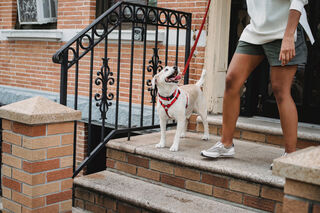Animal Behavior
Helping People Switch to Reward-Based Dog Training Methods
Connections between individual and community-level efforts on training methods.
Posted August 25, 2021 Reviewed by Jessica Schrader
Key points
- Reward-based training methods are better for dogs and recommended by professional associations.
- A range of techniques can help persuade people to switch from aversive methods, including seeing reward-based methods in action.
- People also have to recognize their dog for who they are and may need to make adjustments to suit their dog.

Lately I’ve read various stories in the news about ways to encourage more people to get vaccinated, and I’ve been seeing parallels with dog training.
We know that it’s important to use reward-based dog training methods because aversive methods (like shock collars, prong collars, and leash jerks) have risks. And the good news is that there is a shift toward reward-based methods. But because some people still use those outdated methods, there’s work to be done to help them choose reward-based methods instead.
In both cases—vaccination and training methods—we can see a range of techniques that can help.
For example, to increase vaccination rates we see public health officials having drop-in vaccination centres in the community; letting people who are afraid of needles know there are ways to make it easier; sharing data about the benefits of vaccination; talking about how long this new technology has been in development; right through to vaccine mandates of some form; etc.
And when it comes to dog training, there is also a whole host of ways to persuade more people to use reward-based methods.
The bigger picture in dog training
Position statements from professional organizations like the American Veterinary Society of Animal Behavior, the American College of Veterinary Behaviorists, and the Pet Professional Guild are valuable references to share with people who want more information.
There’s also an ever-increasing set of blog posts, videos, social media accounts, and books (including my own, Wag) dedicated to sharing good information about dog behavior and training. Then there are the dog trainers and animal behaviorists who can work with people who need help. And the humane societies and SPCAs that run reward-based dog training programs in the community.
The individual training a dog
Have you ever thought about how we structure coaching for the humans doing the dog training? At an individual level, there’s a lot to consider in terms of what people already know and the skills they already have—and what they need to learn.
We have to accept that dogs aren’t born knowing how to behave in a human world and won’t do what we want just because we expect it. And there’s a lot of technical skill in training. For example, you need to be able to read the dog’s body language (are they scared?), select a food treat they will like (and troubleshoot if they turn their nose up at it), get the right timing for reward delivery (fast, but only after they’ve done the thing you asked), and so on.
Different levels connect
This takes place in a world in which friends and family all have an opinion on dog training, in which dog training is not regulated (so some of those opinions are outdated and maybe even dangerous), and in which it feels embarrassing if your dog misbehaves in public.
So as well as the technical skills and knowledge about dog behavior, we also have to consider confidence and the ability to ignore those think-they-know-it-alls (or the patience to explain to them why they’re wrong).
For some people, the very first thing they need to learn is that it is, in fact, OK to train your dog with food, and not only is it OK but it works and it’s efficient and your dog will love you for it.
Seeing examples of that in action can also really help people to make the shift.
Meet people (and their dogs) where they are
What’s common to all of these things (whether we’re talking vaccination rates or dog training methods) is that it helps to meet people where they are. Different people have different concerns, so it’s important to present a positive message that helps deal with those things.
People can be surprised to learn just how much of solving dog behavior issues is really about what the people do (or don’t do). Making change is always hard, and it takes time and repetition for new ways to become habits (see 10 tips to integrate dog training into everyday life). Having a dog trainer or a trusted friend as a cheerleader can really help.
Dealing with behavior issues means having compassion for the dog. And sometimes people have to adjust to the fact that their life with their dog won’t be quite how they imagined it—but that’s OK. Some dogs just won’t enjoy off-leash hikes in the mountains, Sunday mornings at the dog park, and being around children playing. If your dog isn’t the kind of dog you’d dreamed of, for whatever reason, there’s an adjustment there.
Looking for the pleasure in what you’ve got and being grateful for the small moments can make all the difference. Like the moment a motorbike backfires and your sound-sensitive dog looks to you for a treat instead of simply shaking like a leaf, and you know you’re making progress. Or the fact that your reactive dog has learned that you are just going to turn and go away from other dogs and so the dog walks just got that much easier. Or the evenings when you get to cuddle on the sofa and those behavior issues no longer feel like they matter because your dog loves you.
A shared love of dogs
Everyone’s dog training journey is different, and learning to live companionably with another species can be hard work. But we know that reward-based methods are the best way to train, whether you’re working on basic obedience or difficult behavior issues.
For anyone working with dogs and their guardians, it’s important to have both expertise and compassion in order to meet people where they are.
The common ground for everyone is a love of dogs. Once people see that reward-based methods are better for their dog and their relationship, it can really make a difference.




